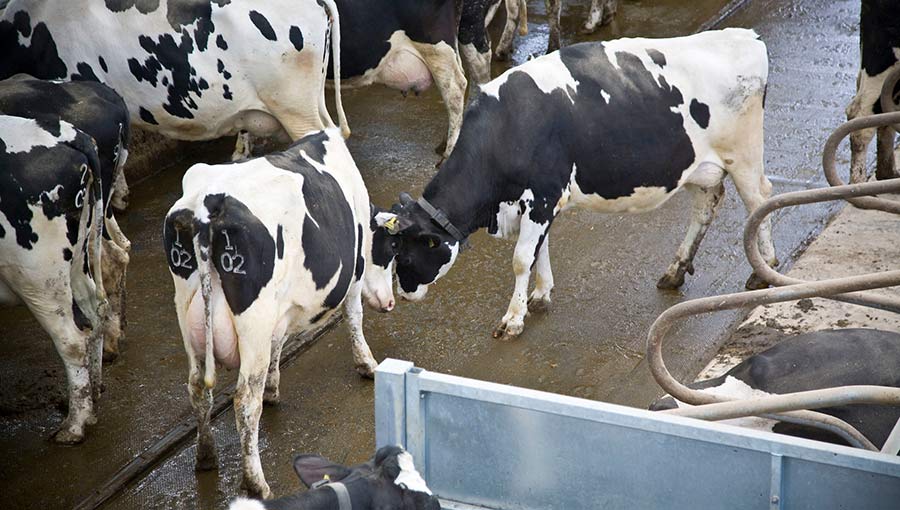4 common Johne’s mistakes and how to avoid them on dairy units
 © Tim Scrivener
© Tim Scrivener Major progress has been made with Johne’s disease control on dairy units, but there are still common on-farm errors, according to veterinary surgeon Peter Orpin, director of Park Vet Group, Leicestershire, and chairman of the Dairy UK Action Johne’s Technical Group.
He outlines some common reasons why Johne’s plans aren’t working:
- Failure to cull red cows.
- Not segregating suspect amber and red animals properly.
- Poor hygiene in calving pens
- Testing for Johne’s and then doing nothing practical with the results to control the disease.
“Failing to cull red cows at the end of lactation is probably the most common reason for Johne’s plan failure,” says Mr Orpin. “Segregation is important. It’s important to segregate the amber cow as well as the red.”
He stresses that it is important to review plans at least annually because people, cows, management and risks can all change and render a plan redundant.
See also: Why dairy farmers should tackle Johne’s now
Farmers Weekly asked National Milk Laboratories veterinary adviser Karen Bond for some advice on how to address the four key mistakes of Johne’s control.
1. Not culling Johne’s-positive cows
Why it’s important:
Fewer red and yellow cows on the farm means fewer management complications and a smaller infected group at calving, making management easier.
How do I address it?
Breeding decisions
- Don’t breed red cows at all if you can possibly avoid it and ask whether you need to serve all of your ambers.
- Make more proactive breeding decisions. If a cow is not bred, she will naturally be a cull at the end of lactation as a barren.
Culling decisions
- Develop a planned culling strategy to benefit the cow and the herd to maximise barren cow value if possible and cull before they start to go downhill.
- Once a cow is Johne’s positive it is a strike against her. If she also has high cell counts, or took six services to get in calf last year, or is yielding poorly, the decision to cull is much easier.
- The higher the test result, the more likely she is shedding. Cull anything testing above 100 once or over 60 twice.
2. Not segregating Johne’s-positive cows
Why it’s important
- Failure to segregate high-risk cows before calving means positive cows can shed Mycobacterium avium subspecies paratuberculosis (MAP) in faeces and contaminate maternity areas, infecting calves as they are born.
- Shedding of bacteria increases as Johne’s disease progresses in each cow.
How do I address it?
Identification
- Effectively identify your high-risk cows (tag/freeze brand) so everyone knows who they are and they do not enter the green maternity area
Managing populations
- How many cows will need to be kept separate at any one time? If it is a small number then you only need a small pen for them; if it’s a larger proportion, see if you can split the dry cow yard.
- Sometimes it’s worth considering calving Johne’s-positive cows in a paddock for most of the year.
- It is best to segregate at drying-off, but if you are struggling for space, segregation at transition, or just in time for calving in a clean calving pen, is better than nothing.
3. Testing and not controlling
Why it’s important
- Simply testing cows will not control Johne’s. It costs about £8-£10 a year a cow for testing, so maximise the investment by making best use of the results.
- Some farms can test for several years and not act on the data, during which time the problem is getting worse.
How do I address it?
- You must discuss test results with your vet and develop a clear plan for each high-risk cow.
- Make sure you act on the results – in other words cull, do not serve or breed to terminal sire.
- Clearly identify your high-risk cows and make sure everyone on farm knows your protocols for them.
4. Improper hygiene and biosecurity in maternity pens
Why it’s important
- The maternity area is particularly high-risk for calves as they are exposed to adult cow muck, which is the biggest source of MAP.
- Overstocking and poor cleaning and bedding practices increase the likelihood of a calf being exposed to MAP before it leaves the maternity area.
- Substandard hygiene practices when harvesting colostrum and milk can expose calves to MAP.
How do I address it?
Protocols
- Always deal with calves first, before cows and heifers. However, if you do need to come to them after milking or checking on adult cattle, an investment in separate clothing and disinfectant will help reduce the risk of transmission.
- Don’t overstock, but if pressure is high in the maternity area, make sure bedding is ample and it is kept as clean as possible.
- Staff training sessions with vets and farm walks are a good idea to show where issues are, where risks are and give staff ownership of disease management.
Communication
- Communication needs to be good so everyone (different shifts, team members) understand the protocols and why they are important.
- Try using laminated sheets, whiteboards and group emails or Whatsapp to ensure consistency.
Disinfectant/hygiene
- Disinfect calving and youngstock areas with a disinfectant with a bTB claim and follow instructions the same way you would for bTB.
- Use separate wellies, overalls and waterproofs to minimise transmission when working with segregated Johne’s-positive animals. Use clean gloves or wash hands and don’t use the same gloves you use for milking.
Colostrum
- Don’t pool colostrum from cows with no test information or that are a known risk. Only take colostrum from known test-negative and low-risk cows. When bagging and freezing colostrum, always label with cow identification number.
- Use good-quality powdered colostrum if sourcing low-risk colostrum is difficult.
